
The climate crisis is intensifying, with 2023 set to be the hottest year on record according to a study using the China global Merged Surface Temperature dataset 2.0 (CMST 2.0).
2023 is projected to be the hottest year ever, with May being the warmest month recorded, based on the CMST 2.0 dataset study.
The climate crisis is reaching an unprecedented level of urgency as global temperatures soar to record-breaking heights, with July 2023 marking another alarming milestone.
Based on the China global Merged Surface Temperature dataset 2.0 (CMST 2.0), a new study led by Prof. Qingxiang Li from Sun Yat-sen University has revealed that 2023 is expected to be the hottest year ever. Li is also a research fellow at the Xinjiang Institute of Ecology and Geography of the Chinese Academy of Sciences.
The findings were published on September 19 in the scientific journal Advances in Atmospheric Sciences.
Analysis of the CMST 2.0 Data and Predictions for the Future
The researchers analyzed the CMST 2.0 dataset and discovered that 2023 has already experienced the third hottest first half-year since records began, narrowly trailing 2016—the warmest year—and 2020—the second warmest. The global mean sea surface temperatures (SSTs) surged to an all-time high in April, while global mean land air temperatures followed suit by reaching their second-highest monthly level in June. This combination resulted in May being crowned the hottest month ever recorded for global mean surface temperatures.
Global temperatures will continue to rise into the second half of 2023, driven by factors including El Niño and widespread wildfires. Both global mean SSTs and global mean land temperatures reached unprecedented highs for July, shattering previous records.
“Given the current trajectory and short-term forecast results of El Niño, along with the extremely positive phase of the Atlantic Multidecadal Oscillation that strongly influences global surface temperatures, 2023 is expected to be the hottest year on record,” said Prof. Li. “Moreover, 2024 may witness even higher global surface temperatures.”
The Significance of the CMST 2.0 Dataset
The CMST 2.0 dataset, developed by Prof. Li’s team, is one of the most comprehensive global surface temperature benchmark datasets to date. It takes into account the accuracy of both global and regional climate change, raising the level of global temperature monitoring to a new level.
The dataset integrates over a century’s worth of global land-air temperature data and state-of-the-art research results from across the globe, resulting in an invaluable resource for climate scientists and policymakers. Based on this dataset, the team was the first to point out that the much-talked-about “global warming hiatus” during the last decade was just a statistical artifact, and in 2022, the dataset was expanded to include Arctic temperature data, further enhancing its global coverage.
Accessible to both the scientific community and the general public, the CMST 2.0 dataset is freely available on the Global Climate Change Observation and Modeling Data Platform.
The Urgent Need for Action
As global warming accelerates, the likelihood of extreme weather events and disasters increases. Therefore, immediate and sustained efforts are needed to mitigate the devastating impacts of climate change.
Reference: “Record-breaking High-temperature Outlook for 2023: An Assessment Based on the China Global Merged Temperature (CMST) Dataset” by Zichen Li, Qingxiang Li and Tianyi Chen, 19 September 2023, Advances in Atmospheric Sciences.
DOI: 10.1007/s00376-023-3200-9

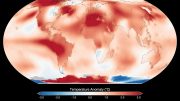
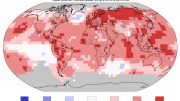
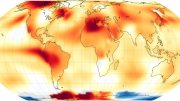
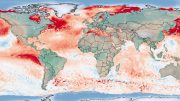
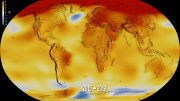

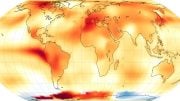

“…, the global mean surface temperature (GMST) in the first half of 2023 reached its third warmest value since the period of instrumental observation began, being only slightly lower than the values recorded in 2016 and 2020, …”
I’m sure you remember 2020. That was the year that everything was shut down because of COVID-19. Anthropogenic CO2 emissions declined 10%, on average, for the year. During the Winter-Spring seasonal ramp-up phase, human emissions of CO2 declined 14-18% in April, just before the annual maximum atmospheric concentration in May, which was indistinguishable from 2019.
These kinds of articles imply that humans are responsible for dangerous warming, without presenting numbers that show that the temperature changes (GMST) are actually imperceptible and only measurable with sophisticated thermometers. By couching the claim in terms of “recorded,” they sidestep acknowledging that there is plentiful evidence that the Medieval and Roman warm periods were at least as warm as currently, before fossil fuels were used.
Remember the TV commercial where the woman asks, “Where’s the beef?” I’d like to know, “Where are the numbers?”
“Both global mean SSTs and global mean land temperatures reached unprecedented highs for July, SHATTERING previous records.”
Again, from their abstract:
“…, if the surface temperature in the last five months of 2023 approaches the average level of the past five years, the annual average surface temperature anomaly in 2023 of APPROXIMATELY 1.26°C will break the previous highest surface temperature, which was recorded in 2016 of APPROXIMATELY 1.25°C …”
I wouldn’t consider a temperature difference of APPROXIMATELY 0.01°C ‘shattering’ anything but credibility. Hyperbole does not get one extra points in science!
“As global warming accelerates, the likelihood of extreme weather events and disasters increases.”
An assertion made without support. What they are claiming is that the current Summer temperatures are in third place, which does not fit the definition of acceleration.
Now tell us all about the snow now falling in the Rockies and it is only September???????
Banks used pencil, paper and erasers to tabulate deposits and withdrawals in 1950. Today, computers. Same with worldwide climate temps. Comparing accuracy in data collecting would be questionable at least.
Ever?? Might be a stretch.
Note for Clyde Spencer: Please review https://globalchange.umich.edu/globalchange1/current/labs/Lab10_Vostok/Vostok.htm It’s clear CO2 followed temperature increases: not the other way around. If not, every time it got hotter more CO2 would be released from the oceans; temperatures would increase; more CO2 released, etc., etc. We would have long ago been in a death spiral.
Clyde – I Apologize as my independent analysis of Vostok showed the opposite of this analysis and I missed the scale of the X axis timeline. Maybe one less scotch would have helped, but I still stand by my Vosok data reduction.
Thanks for the link. I’ll review it. In the meantime, I’ve recently been looking at the Vostok data. I don’t think that the temporal resolution is sufficient to support your initial claim. However, IIRC, the ice core data from Law Dome C does!
Most of the CO2 seems related to biological activity, with the seasonal ramp-up phase occurring from late-Fall through early-Spring, with the amplitude of the seasonal changes increasing northward from the South Pole to the North Pole.
Incidentally, most of the Vostok data I have seen reverses the arrow of time from the convention of increasing from left to right. Be sure you have got the time relationship correct.